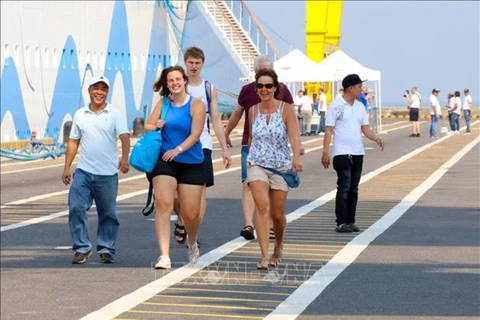
Hanoi (VNA) – Stronger cooperation between the aviation and tourism sectors are crucial to further promote tourism activities, which is expected to benefit both industries and the whole economy, according to experts.
This year, Vietnam tourism sector aims to serve 17-18 million international visitors and 110 million domestic travellers to earn about 840 trillion VND (33.01 billion USD).
Experts held that tourism and aviation have a close relation, sharing a mutual support and inseparable ties in their development process. Both are service industries, meaning products cannot be stored and they rely heavily on technology to provide effective and convenient services for customers.
According to the Civil Aviation Authority of Vietnam (CAAV), domestic airlines are currently operating 45 air routes connecting Hanoi, Ho Chi Minh City, and Da Nang city with 19 localities across the country, with nearly 600 domestic flights per day.
Last year, there were 43,000 flights conducted on the Hanoi-HCM City route, accounting for 17.5% of the total domestic fights, making it one of the 10 busiest in the world.
At present, 63 foreign airlines and four domestic carriers are operating 164 international routes, connecting 33 countries and territories with six destinations in Vietnam, namely Hanoi, Ho Chi Minh City, Da Nang, Khanh Hoa, Phu Quoc, and Da Lat. The international flight network has been completely restored to the pre-COVID-19 level, and expanded to new markets in Central Asia, India, and Australia.
CAAV Deputy Director Do Hong Cam said that international air transportation has contributed to strong international tourist growth. The country recorded 7.6 million international arrivals during the first five months of this year, respectively increasing 61.7% and 3.9% over the same period last year and the pre-pandemic 2019. The figure is expected to reach 18 million this year.
Statistics showed that the number of tourists arriving in Vietnam by air accounts for a very high rate of nearly 80% compared to other modes of transportation.
However, due to many reasons, including high fuel prices, engine rents and USD/VND exchange rate differences, domestic airfares have surged over the recent past, while global airfares are predicted to rise 3-7% this year and more in following years.
The hike has negatively affected the aviation and tourism sectors as well as other economic areas and the livelihood of local communities.
According to experts from the Vietnam Tourism Advisory Board (TAB), domestic air ticket prices can be reduced through comprehensive coordination among relevant entities, including the Government, ministries, sectors, localities, and businesses.
The cooperation should go beyond joint advertisements and promotions to building a phased general plan to generate long-term effects, said Hoang Nhan Chinh, head of the TAB Secretariat.
He held that the two sectors should organise forums to discuss each other’s strengths and weaknesses, along with urgent actions to support each other to ensure benefits for all, including aviation and tourism firms, destinations, local administrations, and communities./.






















